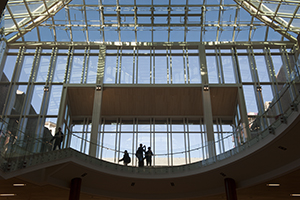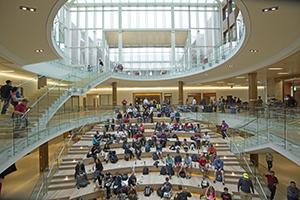
Knight Hall and Bauer Hall are the latest buildings at Washington University in St. Louis to earn Leadership in Energy and Environmental Design (LEED) Gold certification for their green design and construction.
Home to Olin Business School, Knight and Bauer halls on the Danforth Campus feature locally sourced and recycled materials, high-tech glass and an innovative layout that fosters collaboration.
“A building can create community,” said James Kolker, assistant vice chancellor of campus planning and director of capital projects. “The atrium has become a vertical town square, while the open, flexible spaces that surround it invite connection and collaboration. They also make the building more sustainable. Rooms can be used for multiple functions, and the less you build, the less energy you use.”
Washington University now has 18 LEED Gold or Silver buildings on the Danforth and School of Medicine campuses. The McMillan Hall addition also recently earned Gold certification. The Lofts at Washington University, which debuted in August, and the Brown School expansion, expected to open in 2015, are on track to earn LEED Platinum status. A leader in green construction, Washington University committed in 2008 to meet or exceed Silver certification for all new construction or major renovations.

Knight and Bauer halls opened in spring 2014 and are joined by a three-story glass atrium that rises above the open space at the center called the Frick Forum. The atrium glass is covered in a high-tech coating that absorbs different characteristics of the sunlight while maintaining transparency. Architects also used frit — colored ceramic dots — to control transmitted light and limit solar gain.
“This is a building that is all about natural light — we wanted light to penetrate all five floors,” Kolker said. “But we needed to provide appropriate shielding from direct sunlight and not take on too much thermal load. With advances in glass technology, we were able to accomplish that goal.”
The design of Knight and Bauer halls not only is functional and sustainable, Kolker said, but also it serves as an expression of Olin’s values.
“Different business schools have different visions, missions and goals,” Kolker said. “We visited other business schools and saw examples that looked back in time and felt more like a country club than a forward-thinking academic community.
“That would not be right for Olin,” he said. “Olin should look ahead.”